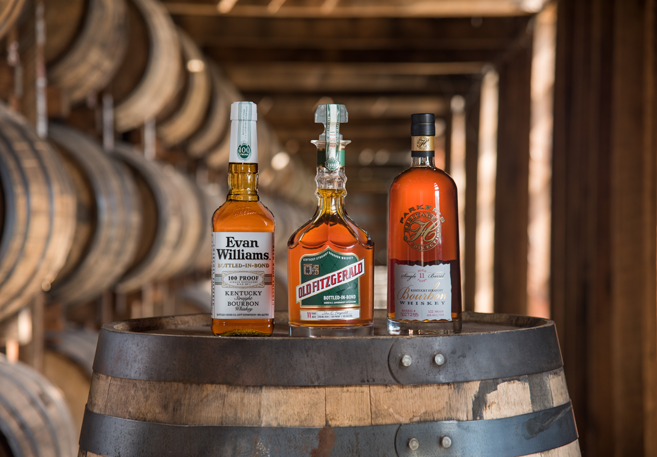Behind the BIB
Here’s a bit of barstool wisdom: If a bartender doesn’t recognize the term Bottled-in-Bond (BIB), just order a beer or wine. It’ll save you some disappointment and dollars.
Good bartenders—especially those in Kentucky — are well acquainted with this obscure government designation, its history and just how few spirits brands bear it. They know these 100-proof beauts are excellent sipped neat or as the base of countless cocktails. And if said bartender is really engaging and friendly, he or she will tell you that many lower-priced BIB spirits taste better than many of the unduly lusted-after limited releases costing hundreds of dollars.
The easiest way to understand what makes BIB spirits so unique and so good is to taste them in cocktails, says Bernie Lubbers, a Heaven Hill Distillery brand ambassador representing the firm’s American whiskey portfolio. Since cocktails are diluted after stirring or shaking with ice, Lubbers says the influence of an 80- or 90-proof spirit is significantly diminished.
“But if you start with a 100-proof spirit, it’ll not only stand up, it’ll complement the other parts of the drink,” says Lubbers, a.k.a. The Whiskey Professor. “If the proof gets too high, the drink might be out of balance. So a 100-proof Bottled-in-Bond is the sweet spot.”
Why BIB? A splash of history
Throughout the 1800s, rectifiers commonly tainted un-aged spirits with additives designed to make them appear and taste aged. That flavor finagling not only made them truly awful, it made truthful distillers awfully mad that drinkers might confuse their delicious products with those of the imposters.
In 1897, the federal government passed the Bottled-in- Bond Act to provide honest distillers a way to guarantee drinkers were getting spirits of high quality, purity and proven age. Under the act, a Bottledin- Bond spirit had to be:
• The product of one distilling season (January to June or July to December)
• The product of one distillery
• Aged in a government- bonded warehouse for a minimum of four years
• Bottled at 100 proof
• Clear in its labeling of where it was distilled and bottled
Why BIBs are truly special
But when there are countless 100-proof spirits on bar shelves, what makes Bottled-in- Bond brands unique? Proof plays a significant role in any spirit, but it’s only half the story, at best, of BIB spirits. For example, most American whiskeys come off the still between 135 proof and 140 proof, so achieving 100 proof at bottling isn’t magic. Where a BIB whiskey gets its distinguishing flavors of oak, vanilla, spice, citrus and more is from a guaranteed rest of at least four years in an oak barrel where contact with the wood and myriad chemical reactions influence flavor.
In the 122 years since the act passed, broader-sweeping laws regulating drink production have arguably made the Bottled-in-Bond Act superfluous, yet at least 17 distillers still follow its mandates and market those spirits accordingly. Why? Because bartenders and educated consumers know and appreciate their differences.
The internet has been highly influential in BIB’s resurgent popularity, says Lubbers. In closed and public forums, spirits fans share stories of great finds, facts and figures, not to mention bargains to be had in BIB spirits. As a result, it’s not uncommon to see empty spaces on retailers’ shelves where BIB spirits once were.
“My dad used to call Bottled- in-Bond, ‘the good stuff because it’s controlled by the government,’” Lubbers says.
“He knew long before social media that it meant quality.”
Affordable and Everywhere—at Least in Kentucky
Of the 31 BIB spirits on the market today, 27 are either bourbon or rye whiskeys. The other three include a corn whiskey, an applejack brandy and a grape brandy. Prices range from $14 for Very Old Barton (a super-bargain if you ask me) to around $65 for Col. E.H. Taylor Rye, and as high as $120 for biannual releases of Old Fitzgerald. The bulk of BIB offerings, however, are clustered in the $20 to $30 range, making them affordable as daily drinkers and cocktail spirits.
Of the 31 BIBs I could find, the three that aren’t available in Kentucky are from far-away craft distilleries with limited shipping. Expectedly, most BIBs are made by the country’s larger distillers including eight at Heaven Hill and four at Jim Beam. The rest are spread fairly evenly: Buffalo Trace (two), Barton 1792 (two), Jack Daniel’s (one), Early Times (two), Willett (one), Wilderness Trail (one) and New Riff Distilling (one).
Like many brand representatives who travel the U.S. and abroad, Lubbers says he hears endless complaints from bartenders who can’t get BIBs onto their shelves. What few of them understand is BIB spirits will never be in huge supply.
“That one line in the law—‘made in one distilling season’—limits your production of Bottled-in-Bond spirits,” he says. “You can’t take whiskey from one season and blend it with whiskey from another season. That’s one reason why it’s in perpetually short supply in most places, except Kentucky. We’re so lucky here, and I think we take it for granted.”
Frankfort / Franklin County Tourist Commission
100 capital Ave.
Frankfort, Ky 40601
502-875-8687
inquire@visitfrankfort.com
www.visitfrankfort.com
Catch the Bourbon Boat — the Only Boat-based Bourbon Tour!
Experience Kentucky Bourbon by boat — a new way to learn about the Kentucky River’s influence on the history of bourbon. Come see why early whiskey distillers cherished this river, and decided to build their fortunes on its banks. Let Kentucky River Tours take you! Or take a Bourbon Paddle Tour with Canoe Kentucky. Travel by canoe or kayak through a lock, then stop at Buffalo Trace Distillery for a tour and sample.
America’s Bottled-in-Bond Spirits
Following is the current list of BIBs on the market, including brief notes from my own sips of many.
• A.D. Laws Four Grain Straight Bourbon
• A.D. Laws Secale Straight Rye
• Barton’s 1792 Bourbon, 8 year (banana bread, s’mores)**
• Catoctin Creek Rabble Rouser Rye (spicy, pricey Early American–style rye, love it)
• Col. E.H. Taylor Bourbon (supple on the palate, graham cracker, honey, toasted oak)
• Col. E.H. Taylor Rye (gentle spice, graham cracker, white chocolate)
• Christian Brothers Sacred Bond Brandy (grape, oak, anise, cocktailer)
• David Nicholson 1843 (simply delicious, a real sleeper)
• Early Times Bottled-in-Bond (milk chocolate, caramel, surprisingly great sipper)
• Evan Williams (simple, soft and fruity sipper) *
• Henry McKenna, 10 year (second-oldest BIB, delicious and worth the hunt) *
• J. Becher Straight American Rye Whiskey Bottled in Bond
• Jack Daniel’s Bottled-in-Bond
• Jim Beam Bonded (good cocktailer, OK sipper)
• J.T.S. Brown (good cocktailer buy @ less than $10, but not a sipper) *
• J.W. Dant Bourbon (rye leads, lacks softness, spicy sipper, good cocktailer) *
• Laird’s Straight Apple Brandy (opens your mind to apple brandy, fun cocktailer)
• Mellow Corn (loads o’ corn with honey and cake batter)
• New Riff Distillery Bourbon
• Old Bardstown Bottled in Bond (new iterations lead with rye and dill, not a favorite)
• Old Fitzgerald 13-Year-Old (oldest BIB, peaches, piecrust, caramel, oak, superb)
• Old Forester 1897 (prefer its sibling, Old Forester 100 proof, for the price)
• Old Grand-Dad (powerful sipper, bold cocktailer, old-timey fave)
• Old Overholt (prickly, unpleasantly herbaceous, not a fave)
• Old Tub (despite strange name, really nice whiskey)
• Oregon Spirit Distillers Bourbon Whiskey
• Oregon Spirit Distillers Wheat Whiskey
• Oregon Spirit Distillers Straight American Rye Whiskey
• Rittenhouse Rye (baddest cocktail BIB, spicy sipper, delicious all around)
• Very Old Barton Bourbon (banana bread, caramel, oak, great bargain)**
• Wilderness Trail Kentucky Straight Bourbon (rye, oak, heat, needs age)





